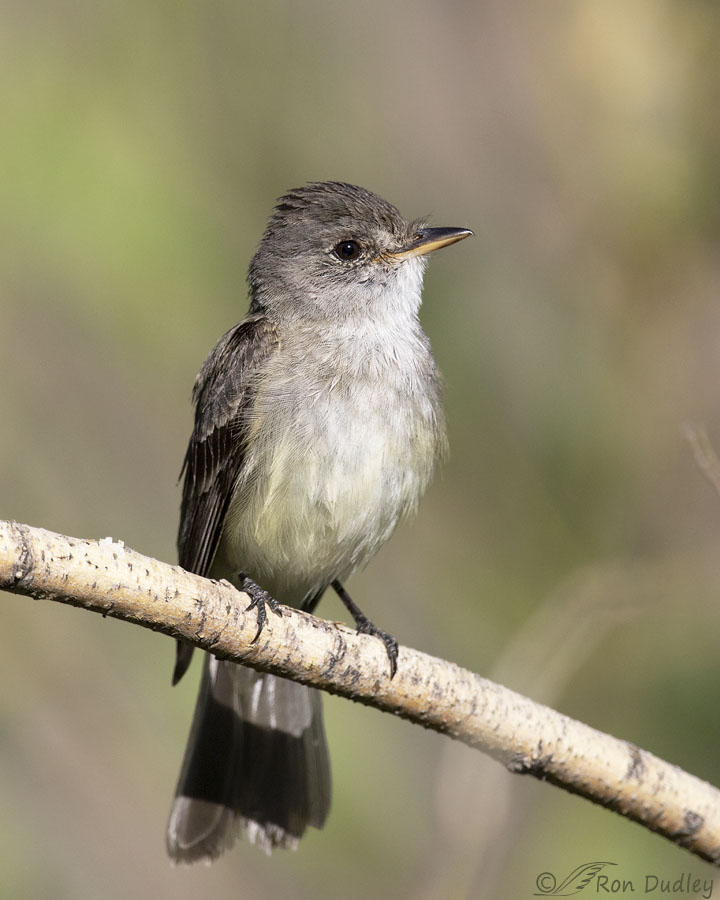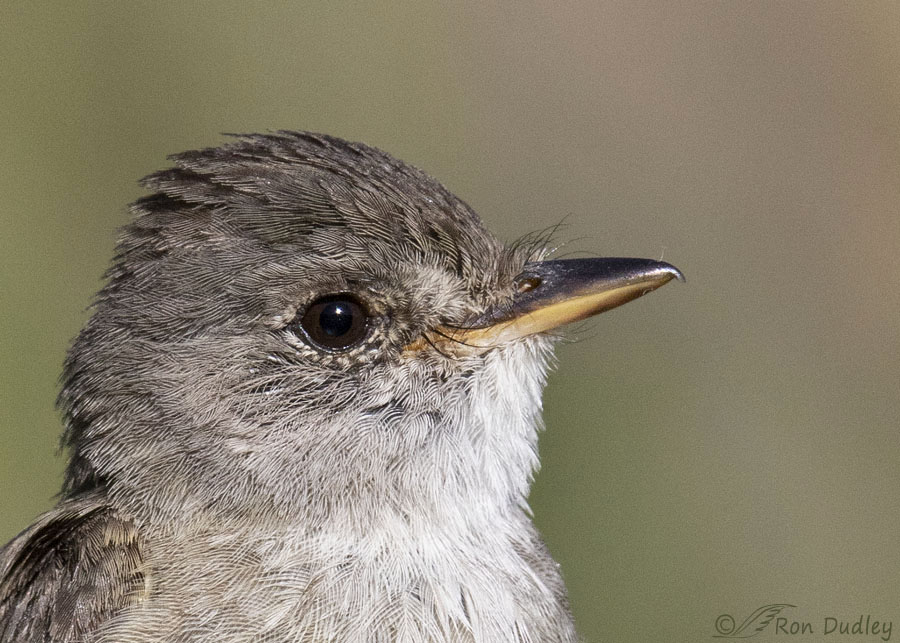And a better explanation of why I like to crop significantly to get even more detail in my sharper images.

1/4000, f/7.1, ISO 800, Canon 7D Mark II, Canon EF 500mm f/4L IS II USM + EF 1.4 III Extender, not baited, set up or called in
A week ago today while I was attempting to photograph other birds in the mountains I was very surprised when this Willow Flycatcher landed directly in front of my lens, so close I could barely keep all of ‘him’ in frame vertically. I knew I wouldn’t like my photos without enough room above and below the bird for an acceptable composition so I took a chance and took the time to rotate my camera to vertical for this and other photos.
When I do that at least as often as not the bird takes off while I’m in the process of rotating but thankfully this guy stuck.
This was one of those times when I’m convinced that the bird landed as close as it did because he was curious about me and my pickup. Most of the time he was here he appeared to be looking directly at me or somewhere else inside my pickup. He put up with the loudly clicking shutters and just stared. I’m glad I took the chance and rotated because I like the background and the fine detail in most of the bird, despite the soft tail (not enough depth of field at this close distance).

So you know me, I cropped in tightly on his head to enjoy more of that detail. I do this often enough that some readers may be growing weary of it but this is an opportunity that relatively few people ever get with a wild bird so I often can’t resist.
Think about it. This is a close-up view at much larger than life size (if you’re looking at it on a big screen like I am) and at a sufficient resolution to show significantly more detail than you’d be able to see even if you had the bird in the hand. Watching this bird in the field with the naked eye, even if it was as close as this one was, you’d never be able to see fine details like the tiny hook at the end of his bill, the rictal bristles or the fine feather structure as well as this.
And especially for those of us with less than 20/20 vision, seeing this much detail in a wild and free bird can be a real treat.
So that’s why I do it and I’m likely to continue to do it. It tickles my fancy.
Ron


Ah, love the close-up crops! As an artist who loves detail, seeing this much detail in those gorgeous, soft feathers is a treat. I’ve long worked in colored pencil, a very tedious, but delightful medium for the detail nut that I am… There are plenty of us that love your close crops!
Tire of crops and closeups of birds? Never! If anything, it makes you marvel at the intricacies of a bird from it sharp beak to the pattern in its feathers.
And if you wave your mouse over the photo it appears to “brighten” allowing one to see the Flycatcher’s iris and pupil better.
Thank you, Amy.
I’m glad there’s one redeeming quality of that feature that changes the exposure when you pass the mouse over the image. Usually it just aggravates me.
I don’t think I could ever get bored of such a photo! I love seeing the completeness of every tiny feather, and the “whiskers” around the bird’s beak. I have a special fondness for flycatchers. This little one melts my heart! Thanks for indulging your wont to zoom in!
And thank YOU for indulging my wont, Sheila!
The ability to capture this level of detail in photos of very small, very active, often secretive creatures is one of very few things that actually endear me–a card carrying digital neanderthal–to praise (and sometimes adopt…eventually…often grudgingly) modern technologies. That we can actually see and study at leisure this kind of breathtaking detail and beauty without needing to harm the subject I find to be one of the great redeeming features of digital photography.
Having spent considerable time in my youth as a biologist who actively collected, killed and “preserved” once living things in the interest of “science” I have to say–enthusiastically and without reservation–that this method of study is in many respects superior. That is, both technically in some important ways and certainly ethically.
So…please do not stop posting these great detail shots!
Excellent point, Jim. I identify…
I love seeing the detail although it makes me wonder why the views through my excellent 8x binoculars lack the details that are now in my mental field guide.
Do you think any of the feathers are downy, such as the white ones in front of the eye or the wispy ones in front of the wing?
Pam, most of the down feathers would be beneath the contour feathers that we can see.
My fancy is also tickled. Bigly.
LOVE the detail in this shot of a subtle charmer.
Thank you, EC.
Love the close-ups you post…love those details so don’t even ponder not doing it! I especially love the ‘hither and yon’ of those feathers…eye-catching for sure. Also the background here really accents the pale touch of yellow in the breast feathers…beautiful.
I especially love the ‘hither and yon’ of those feathers…eye-catching for sure. Also the background here really accents the pale touch of yellow in the breast feathers…beautiful.
Thanks very much, Kathy. Nice to know you like the background, as I do.
I will NEVER tire of close crops and portraits! Not only is the feather detail beautiful, but also the gradations in color are apparent. I like the way the maxilla curves slightly, giving the illusion of a coy smile as if the flycatcher knows you’re taking a picture and is posing.
And as for vertical vs. horizontal, going horizontal again is great as long as the change is voluntary. Otherwise, not so much.
I see that subtle smile too, Marty. Noticed it while I was processing the image.
What a handsome little guy — and you’re welcome to post closeups as often as you’d like, as far as I’m concerned! The feathers on his face and throat remind me of finely woven wicker … definitely the type of detail I’d never know about without your closeups.
Thanks for the encouragement, Chris.
The tiny feather tufts in the eye ring are a wonder.
“Better explanation” appreciated but the proof is in the pudding. And what a pudding it is. In other words, your crops are tops.
Per your reply to Everett: “Going vertical is a pain”. Don’t I know it. Every morning.
““Going vertical is a pain”. Don’t I know it. Every morning.”
But it sure feels better going horizontal again, doesn’t it Lyle!
I especially loved seeing the translucent, changing directions of the
overlapping feathers around the neck–what beautiful patterns they
make, and surely must be really good insulation, too ! Fabulous detail.
“must be really good insulation”
Exactly, Kris. It’s hard to imagine how many tiny insulating air pockets there are in all those layered feathers.
‘He’ wants to be your new best friend Ron. Who knew your pickup is a bird magnet LOL! What color is it?
It’s silver, Kathleen. At least in theory it is under all that dirt.
Love it, love it – in my mind that close-up is exceptional!
I know you are tired of me saying from time to time that your images, your excellent photography should be in print. And, I just don’t mean locally, but should be in print nationally and worldly. I truly believe it!!
I appreciate your confidence in my photos, Dick. Quite a few of them actually are in print but if you’re talking about a book – not gonna happen.
An exquisite photo, Ron. But what really captures my heart is the expression on “his” face. If this little fellow isn’t winsome, I don’t know who is!
“Winsome” – perfect for the bird and a word I should use more often. Thanks, Alison.
Cool! The feather detail, “whiskers” and hook in the bill are things I’d never notice otherwise! Some “smooth” feathers, some appear to be going different directions around the throat area – must be “fluffed up” a bit……..
The feather detail, “whiskers” and hook in the bill are things I’d never notice otherwise! Some “smooth” feathers, some appear to be going different directions around the throat area – must be “fluffed up” a bit…….. 
Found out the waxwings do a 2nd clutch – they were collection dog hair off an outside mat by the door yesterday with the red tips in full view! Fun!
I’ll bet it was fun, Judy. And a good use for dog hair.
Excellent shot and commentary. Even looking at a bird like this through binoculars before shooting you don’t see this kind of detail. Like that little hook on the bill, and what clear detail of the feathers and the eye.
I often found myself shifting to vertical when taking photos of the owl juveniles earlier this year. As you mention with switching, you just hope the bird doesn’t take off.
Thanks, Everett.
Going vertical is a pain. It’s often hard to get the bird back in the viewfinder because the ‘aiming’ process feels so different and the muscle memory is different. And then you often have to move your active focus point. In the meantime the damn bird has vamoosed…
Amazing how that simple switch complicates everything……….